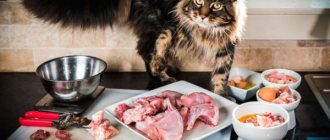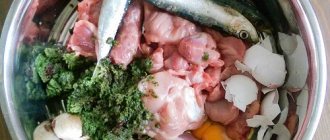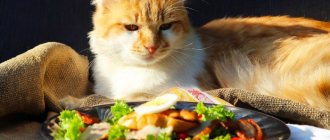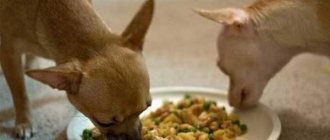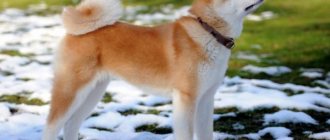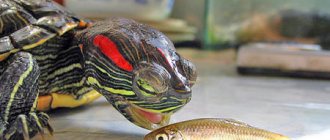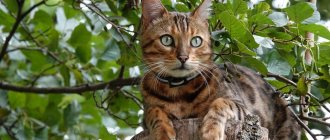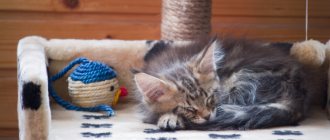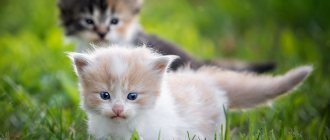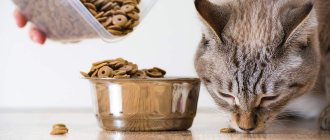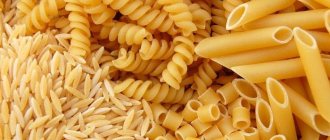Bengal kittens have become popular. People from all over the world are increasingly buying them, and the new breed is conquering more and more people. The owners immediately have a logical question - what to feed their Bengal kittens.
The breed appeared in the last century, it combines the habits of a pet and the body of a predator, with characteristic spots.
What to feed Bengal kittens
Even a person who does not often encounter animals will notice that Bengal cats are different from their four-legged counterparts. Given their wild nature, kittens require special care and want a lot of attention. We will separately consider what to feed such animals.
How to properly create a menu from natural products?
Bengals digest natural food better. However, creating a balanced menu is quite difficult: it is important to maintain the correct ratio of proteins, fats, carbohydrates and microelements. In addition, this method of feeding does not provide the animal with all the necessary vitamins, so they must be given additionally.
Important!
Keep your dishes clean: a dirty bowl can cause you to refuse to eat.
Despite the difficulties in creating a nutrition plan, natural food has a number of advantages:
- the animal receives a sufficient amount of fluid;
- the risk of diabetes and urolithiasis is reduced;
- life expectancy increases;
- there are no problems with the gastrointestinal tract.
Bengals are descendants of small leopard cats that had no contact with humans until the 20th century. Their diet included rodents, fish, birds, and sometimes even hares. Therefore, the Bengal cat inherited a short intestine designed to digest only meat foods.
Therefore, at least 70% of your domestic carnivore’s menu should be meat. What you can and cannot feed a Bengal cat is described in the table.
| Products | Notes | Can't give | |
| Meat | low-fat varieties: rabbit, chicken, veal, chicken necks. offal: lung, heart, stomach, tripe. | no fat; frozen and scalded; room temperature; chicken necks are ground. 70-80% of the diet | pork, lamb, duck, turkey; bones; minced meat with salt and spices; skin |
| Vegetables | carrots, beets, cucumber, zucchini, bell peppers, pumpkin | raw and cooked; up to 20% of the diet | potatoes, eggplants, legumes, onions, garlic, tomatoes |
| Dairy | kefir, fermented baked milk, cottage cheese, sour cream | up to 20% of the diet | milk, cream for kittens |
| Cereals | buckwheat, oatmeal, cereal flakes | up to 7% of the diet | other crops are not recommended |
| Fish | maritime | boiled, no more than once a week | scales, bones, river fish |
| Eggs | quail, chicken | 1-2 times a week raw yolks | squirrels |
| Greenery | spinach, sprouted grass (oats or wheat), salad | daily | grass from the street |
Important!
Select vitamins for your pet together with your veterinarian. Never give him medications intended for humans.
You can prepare food for future use and freeze it in bags. For example, make this mixture:
- ground chicken fillet - 60%;
- raw or boiled vegetables - 10-15%;
- boiled unsalted rice / other cereals - 5-7%;
- chicken necks twisted in a meat grinder - 25%.
Before feeding, the mixture is defrosted. Add yolk, fish oil (5 ml per 1 kg of food), greens and so on. Try to add variety to the recipe.
How much food to give your pet?
- adult cat: 40-60 cal per 1 kg of body weight per day;
- castrated or sterilized individual: 35-50 cal per 1 kg of weight per day;
- castrated or sterilized animal over 7 years old: 30-45 cal per 1 kg of weight;
- pregnant cat: 60-75 cal per day.
Vitamins and supplements
When feeding with high-quality, industrial feed, vitamins and additives are not introduced into the diet. Additional sources of nutrients are necessary if you prefer natural feeding. Even the highest quality and freshest products cannot compensate for the needs of active cats.
Natural vitamin supplements:
- Meat and bone meal.
- Fish, chicken, beef liver.
- Greens, vegetables, fruits.
- Sunflower oil, olive oil.
- Brewer's yeast.
Pharmacy vitamin supplements:
- Fish fat.
- Feed tricalcium phosphate.
- Omega-3, Omega-6.
- B vitamins.
In addition to vitamins and minerals, cats need taurine. Unlike dogs, which synthesize taurine naturally, cats can only obtain this amino acid from food.
Sources of taurine:
- Turkey.
- Rabbit.
- Chicken heart, liver.
- Beef heart.
- Pork, ham, trimmed of fat, after deep freezing.
- Pork liver, heat-treated.
- Ocean fish, shellfish.
- Raw red fish.
- Homemade live yogurt.
- Whole milk.
To make life easier, the owner can conduct vitamin courses using special, industrial supplements. Vitamin complexes are sold in pet stores and veterinary pharmacies, usually available in the form of tablets or powders.
What dry food should you pamper your pet with?
Ready-made food is considered a more balanced food. But they also have disadvantages.
| Advantages | Flaws |
|
|
However, most of the disadvantages are inherent exclusively in cheap options. More expensive ones contain high-quality products, vitamins and various nutritional components.
Feed is divided into 4 groups based on quality:
- Economy class: “Kitekat”, “Whiskas”.
- Premium class: “Hills”, “Bozita”, “Royal Canin Bengal Adult”,
- Super-premium class: “Arden Grange”, “Cimiao”, “1st Choice”, “Chicopee adult cat”.
- Holistic: “Orijen”, “WildCat Etosha”, “Chicken Soup”, “Acana”, “CARNILOVE Salmon for Adult Cats – Sensitive & Long Hair”, “Eukanuba Adult with Chicken”
Important!
Food for Bengals should not have a fat content higher than 20%.
Small carnivores have very sensitive digestive systems, so the best choice for them would be a holistic diet. Let's take a closer look at some options from this group.
- "WildCat Etosha": good composition with a vitamin complex. Contains a lot of protein, while there are no cereals. The only drawback is the price - 3 kg costs 2,400 rubles.
- “Eukanuba Adult with Chicken”: optimal protein content for Bengals. It also has a good composition, but contains wheat, which contributes to the rapid weight gain of the cat. Price - 4416 rubles per 10 kg.
- "Orijen": fish is used as a source of proteins and fats. But legumes are responsible for carbohydrates, which are not recommended for Bengal cats. But it contains a large amount of vitamins and probiotics, which have a good effect on intestinal flora. Price for 5.4 kg - 3999 rubles.
Take a responsible approach to the decision to purchase food: this breed has a hard time with a change in diet. It’s better to check with the breeder what the domestic leopard ate and according to what diet.
Important!
You cannot mix food of different manufacturers and consistencies in one meal.
If you want to diversify your pet's diet, it is recommended to give wet food. But choose the same manufacturer and product line. Maintain the proportion: 75% of the daily requirement is dry food, the rest is wet. For show cats, use the 50/50 formula.
Make sure your cat always has clean water at room temperature.
Diet for illnesses
What to feed a Bengal cat if he has health problems? This is not an idle question, but a very important one. Bengals enjoy good health and rarely suffer from genetic diseases. However, their shortened intestines can become a problem of dysbiosis, diarrhea or constipation. In such cases, special medicated food will help, which should be prescribed by a veterinarian after examining the pet.
Medicinal food for cats with gastrointestinal diseases:
- Hill's Prescription Diet;
- Purina Veterinary Diets EN ST/OX;
- Hill's "W/D"
- Royal Canin FIBER RESPONSE FR31;
- Royal Canin Digestive Care.
Despite their natural activity and curiosity, some Bengal cats, especially neutered and elderly ones, manage to gain excess weight. Obesity worsens the quality of life of an animal and shortens its life expectancy. It is useful to switch overweight cats to food from the “Weight Control” line.
Naturally, it is necessary to decide what food to feed an obese animal only after consultation with veterinarians.
Food series “Weight Control”:
- Nutram I12;
- 1st Choice WEIGHT CONTROL for ADULT CATS;
- Eukanuba Adult Dry Cat Food For Sterilized Cats Weight Control;
- 1st Choice Mature or Less Active;
- Royal Canin Sensitivity Control SC27.
Recommended diet
For Bengals, a mixed diet is optimal: dry food without restrictions on access and, as a supplement, natural products 1-2 times a day.
It is believed that the body produces different enzymes to digest dry and natural food, so be sure to maintain a time interval of at least 2 hours between them. For convenience, create a meal schedule.
If you have a kitten or an unsterilized young animal, then it is necessary to remove the remaining food when the animal leaves it after a meal.
Adult sterilized cats and female cats need a diet without excess calories. Choose specialized series and follow the instructions on the packaging.
For natural food, also follow some rules:
- make the menu varied;
- consider your pet’s taste preferences;
- do not feed cold or hot food;
- meat should always be fresh;
- do not give sweets;
- do not add spices.
If the animal is in good physical shape, looks healthy and well-groomed, then the diet for it is chosen correctly.
What not to feed Bengal cats
There is also a list of products that you should absolutely not give to your four-legged friends. It included:
- any fatty meat, duck, lamb;
- pork, because not all parasites in it are killed by freezing;
- any sweets, including chocolate;
Sweets are not allowed for cats
- any bones that are often given to cats and dogs from the table;
- fish without bones. Bones can injure the insides of the animal.
Most foods that people love to eat are dangerous for cats. They cause indigestion, weakness, urolithiasis and other troubles. You can learn more about what you should not feed cats in our separate article.
Kitten food
The nutrition of a small Bengal should be given special attention, because the health, size and even the abilities of an adult cat depend on it.
Nutrition for kittens up to 2 months
In the first month of life, the kitten needs only milk. Usually such little ones are not sold, and their mother cat feeds them. But if for some reason you have a baby, then the best option would be a milk suspension for kittens. Cow's milk is not suitable for them; it causes intestinal dysfunction. At the age of 1.5-2 months, you can start complementary feeding.
Important!
Like an adult, a kitten can be given food or natural food. When choosing the type of food, base it on what he ate from the breeders. You cannot suddenly change the way and mode of nutrition. This should happen gradually: over about a month.
Feeding with natural food
Until four months, the kitten is fed at least 5 times a day. The basis of his diet at this time consists of:
- lean boiled meat;
- boiled fish;
- vegetable porridge;
- eggs;
- dairy products.
Food must be safe: without bones, skin, beaks or claws. And don’t forget about the water: change it at least once a day.
Like an adult animal, a baby Bengal's diet is based on meat - up to 80% of daily food. For the first feeding, use scraped frozen meat and meat porridges cooked in water. Later cut it into small pieces. Replace with liver or heart 1-2 times a week.
Sometimes give your kitten boiled red fish (salmon, trout, pink salmon). Don’t forget about porridge: you can cook buckwheat, oatmeal and wheat.
Important!
From the 13th week, eliminate milk from your diet. Vegetables are an essential element of a Bengal's diet. They should be given crushed or in the form of porridge.
Accustom your kitten to fermented milk products. It is useful for him to eat kefir, fermented baked milk, sour cream. Also, be sure to pick up a complex of vitamins and calcium supplements for your baby.
Kitten food
As with the natural method, it is recommended to do the first complementary feeding when the kitten is 1.5 months old. Start with wet types - pates or mousses. Solid food is too much for kittens at this age. The transition to dry food is carried out only after 4 months.
5 recommended foods for Bengal kittens:
- "Acana Regions Wild Prairie Cat & Kitten."
- Orijen Cat & Kitten.
- "Carnilove Kitten Salmon & Turkey Grain-Free."
- "Wahre Liebe "Junge".
- "ROYAL CANIN Kitten".
How many times should you feed a kitten?
| Kitten age | How many times a day to feed | How much food to give per day |
| up to 2 weeks | 10 times (including night) | up to 120 g |
| 2 weeks – month | 8 times (including night) | |
| 1-2 months | 7 times (no more at night) | 160-180 g |
| 2-3 months | 6 times | |
| 4-5 months | 5 times | 180-240 g |
| 5-9 months | 4 times | |
| 9-12 months | 3 times | 150-200 g |
Important!
It is not recommended to switch Bengals to food for adult animals until they are one year old.
Choosing a place and utensils for feeding
After moving to a new home, the kitten is stressed, although it may not show it outwardly. Separation from the mother and change of environment can turn stress into physical illness. To simplify the adaptation process, the future owner needs to prepare the conditions for the kitten in advance.
The choice of place and utensils for feeding plays an important role in the adaptation of the pet. While eating, the kitten should feel comfortable and safe. If you have other pets in the house, try to feed the newbie separately so he doesn't have to compete for food.
The eating area should be comfortable for the pet and clean. To make cleaning easier, you can place a small rubber mat under the bowls. The rubber coating is easy to clean; in addition, the mat prevents the kitten from slipping if he is in a hurry to get to the bowl.
Give preference to ceramic or stainless steel bowls. The downside of ceramic bowls is that they break when dropped from a height. The advantages include ease of care and significant weight - ceramic bowls do not slip. Stainless steel bowls are unbreakable and can be treated with boiling water. However, steel bowls are lightweight, so they need to be placed on a stand.
Some useful tips
How much food should I feed? Bengals are not gluttons; they usually eat as much food as they need. Anything left after eating should be removed. Problems with overeating sometimes occur in neutered dogs. If the kitten becomes overweight, you need to reduce the portion size and control the calorie content of the food.
Bengals are active and always have a good appetite. When a kitten of any age does not eat or drink or drinks little water, this is a very dangerous symptom. He needs to be taken to the vet immediately.
A kitten's digestion will benefit if the pet receives food on a regular schedule. An egg, like chopped vegetables, can be added to porridge. It must be very fresh and from a trusted source to prevent salmonella contamination.
Bengals love to drink water and play with it with pleasure. For drinking you need a spacious and heavy bowl. Plastic will not work; it is better to take a container made of glass, ceramics or stainless steel. It will be inconvenient to drink from a small bowl; a playful pet may turn over a light plastic product. Feeding containers should also be spacious and heavy. Use only clean drinking water. If the quality of tap water does not meet these requirements, you need to buy bottled water without gas.
If the kitten remains active, looks healthy, has a shiny coat and normal stool, we can confidently assume that the diet has been chosen correctly. High-quality food, good care, and ample space for play will provide protection—everything Bengals need to be happy.
Transfer to new food
Veterinarians advise choosing a feeding method once and for all, but sometimes it becomes necessary to change dry or wet ready-made food to meat and cereals. In this situation you need to be very careful. The sensitive digestive system of Bengals does not like sudden changes in food, so you need to transfer your pet to a new diet gradually and with the utmost care.
Before feeding your Bengal cat a new food, it is better to do a little testing: add some of the selected food to the cat's regular menu and check if she agrees to eat this product and if she feels good after such a meal.
What else to see:
Water
At any age, regardless of the type of Bengal diet, drinking water should always be freely available in the bowl. Do not give your cat water from the tap. It contains chlorine and other chemical compounds that are unsafe for animals.
Veterinarians recommend using pre-settled, filtered soft drinking water for kittens to drink. You can also give your kitten bottled artesian water without gas.
Always wash bowls before adding water. The water is changed once or twice every knock. Make sure that there are no food particles, insects, or other third-party particles in it.
What you should absolutely not give
What to give your pet - dry food or natural food - is up to you. To prevent your animal from having intestinal problems, take note of the list of treats that you should never feed it with. The following prohibited products are identified:
- fatty meat (duck, pork, turkey). Firstly, it will be difficult for the cat to absorb. Secondly, a cat can become infected with helminths or dangerous infectious diseases from poultry;
- smoked and spicy dishes;
- sweets. This is generally taboo for the Bengal cat. From them, her teeth and fur can deteriorate, and her metabolism is noticeably disrupted;
- peas, beans and soybeans. If your pet consumes these products, bloating will inevitably occur;
- salty or peppery food. No spices, otherwise you will have to treat the cat for serious stomach problems.
Similar article: Characteristics of a samurai cat of the Japanese Bobtail breed
There are times when a cat suddenly gets sick. No matter what the cause was, treating your pet with human vitamins and medications is strictly prohibited. Otherwise, the animal’s kidneys may fail or the body may even become poisoned. Follow the key recommendations regarding feeding your four-legged friend, and he will delight you with his good health and excellent appearance.
